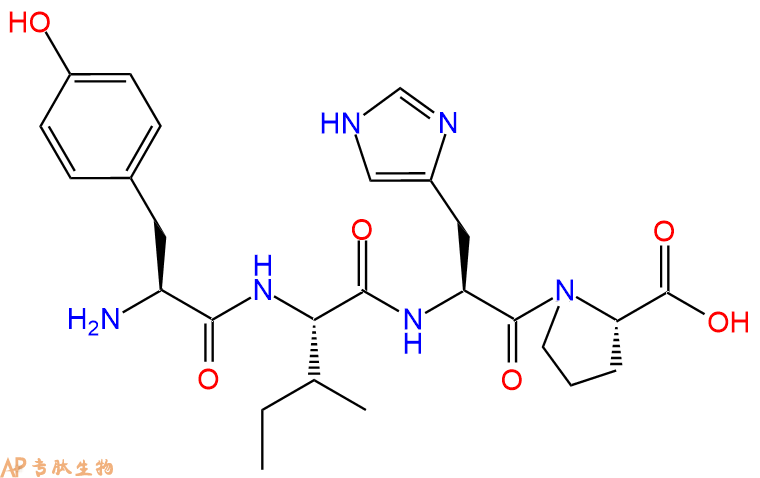400-998-5282
专注多肽 服务科研
400-998-5282
专注多肽 服务科研

凝血酶原又称为凝血因子II,产生于肝脏,其翻译后修饰具有维生素K依赖性,将凝血酶原上的10位谷氨酸转变成γ-羧基谷氨酸( GLA)。
编号:431163
CAS号:
单字母:H2N-YIHP-OH
| 编号: | 431163 |
| 中文名称: | 凝血酶原又称为凝血因子Prothrombin (474-477) [Mus musculus] |
| 英文名: | Prothrombin (474-477) [Mus musculus] |
| 单字母: | H2N-YIHP-OH |
| 三字母: | H2N N端氨基:N-terminal amino group。在肽或多肽链中含有游离a-氨基的氨基酸一端。在表示氨基酸序列时,通常将N端放在肽链的左边。 -TyrL-酪氨酸:tyrosine。系统命名为(2S)-氨基-3-(4-羟基苯基)丙酸。是编码氨基酸。符号:Y,Tyr。 -IleL-异亮氨酸:isoleucine。系统命名为(2S)-氨基-(3R)-甲基戊酸。是编码氨基酸。有两个手性碳原子,是哺乳动物的必需氨基酸。符号:I,Ile。 -HisL-组氨酸:histidine。系统命名为(2S)-氨基-3-(4-咪唑基)丙酸。其侧链带有弱碱性的咪唑基,为编码氨基酸。是幼小哺乳动物的必需氨基酸。符号:H,His。 -ProL-脯氨酸:proline。系统命名为吡咯烷-(2S)-羧酸。为亚氨基酸。是编码氨基酸。在肽链中有特殊作用,如易形成顺式的肽键等。符号:P,Pro。 -OHC端羧基:C-terminal carboxyl group。在肽或多肽链中含有游离羧基的氨基酸一端。在表示氨基酸序列时,通常将C端放在肽链的右边。 |
| 氨基酸个数: | 4 |
| 分子式: | C26H36N6O6 |
| 平均分子量: | 528.6 |
| 精确分子量: | 528.27 |
| 等电点(PI): | - |
| pH=7.0时的净电荷数: | 2.21 |
| 平均亲水性: | -1.9 |
| 疏水性值: | -0.3 |
| 消光系数: | 1490 |
| 标签: | 凝血酶(Thrombin) |
凝血酶原又称为凝血因子II,氨基酸序列为H2N-Tyr-Ile-His-Pro-OH,产生于肝脏,其翻译后修饰具有维生素K依赖性,将凝血酶原上的10位谷氨酸转变成γ-羧基谷氨酸( GLA)。
在凝血级联反应中,凝血酶原经蛋白水解之后形成凝血酶,最终阻止失血过程。凝血酶反过来作为一个丝氨酸蛋白酶,将可溶性纤维蛋白原转变成不溶的纤维蛋白,催化许多其它相关的凝血反应。
凝血酶原的激活在生理和病理凝血功能中至关重要。凝血酶原涉及许多罕见疾病,例如低凝血酶原血症。在自身免疫性疾病中,抗凝血酶原的抗体是引起狼疮抗凝物的一个因素,也被称为抗磷脂综合征。G20210A突变引起低凝血酶原血症,因此,控制凝血酶原是大多数抗凝血剂的核心作用方式。
"Peptide H-YIHP-OH is a Research Peptide with significant interest within the field academic and medical research. Recent citations using H-YIHP-OH include the following: Molecular dynamics investigation on the interaction of human angiotensin-converting enzyme with tetrapeptide inhibitors X Liu, Z Wang, Y Gao, C Liu, J Wang, L Fang - Physical Chemistry , 2021 - pubs.rsc.orghttps://pubs.rsc.org/en/content/articlehtml/2021/cp/d1cp00172h Signaling in Escherichia coli biofilms TK Wood , WE Bentley - Lab-on-a-Chip, 2009 - Citeseerhttps://citeseerx.ist.psu.edu/document?repid=rep1&type=pdf&doi=52402204b94c8742e0f171659a740672de46a9a2 Lethal factor active-site mutations affect catalytic activity in vitro SE Hammond, PC Hanna - Infection and immunity, 1998 - Am Soc Microbiolhttps://journals.asm.org/doi/abs/10.1128/iai.66.5.2374-2378.1998 Solubilization and identification of human placental endothelin receptor S Nakajo, M Sugiura, RM Snajdar, FH Boehm - Biochemical and , 1989 - Elsevierhttps://www.sciencedirect.com/science/article/pii/0006291X89917038 Development of a molecular description of the Embden-Meyerhof-Parnas sulfoglycolysis pathway P Abayakoon - 2019 - minerva-access.unimelb.edu.auhttps://minerva-access.unimelb.edu.au/bitstream/handle/11343/230871/a03e2b23-dc7a-e911-94a1-0050568d7800_Development_of_a_molecular_description_of_the_EMP_sulfoglycolysis_pathway.pdf?sequence=1&isAllowed=y Molecular basis of sulfosugar selectivity in sulfoglycolysis M Sharma , P Abayakoon, R Epa , Y Jin - ACS Central , 2021 - ACS Publicationshttps://pubs.acs.org/doi/abs/10.1021/acscentsci.0c01285 Overexpression and characterization of two unknown proteins, YicI and YihQ, originated from Escherichia coli M Okuyama , H Mori, S Chiba, A Kimura - Protein expression and , 2004 - Elsevierhttps://www.sciencedirect.com/science/article/pii/S104659280400172X YdgG (TqsA) Controls Biofilm Formation in Escherichia coli K-12 through Autoinducer 2 Transport M Herzberg , IK Kaye, W Peti , TK Wood - Journal of bacteriology, 2006 - Am Soc Microbiolhttps://journals.asm.org/doi/abs/10.1128/jb.188.2.587-598.2006 Molecular basis of angiotensin-and thrombin-induced endothelium-independent vasoconstriction and proliferation LK Polevaya - Letters in Peptide Science, 1996 - Springerhttps://link.springer.com/article/10.1007/BF00128116 Sulphoglycolysis in Escherichia coli K-12 closes a gap in the biogeochemical sulphur cycle K Denger, M Weiss, AK Felux, A Schneider , C Mayer - Nature, 2014 - nature.comhttps://www.nature.com/articles/nature12947 Structural and functional characterization of the Na+-translocating NADH: quinone oxidoreductase from Vibrio cholerae and YihU of the sulfoglycolysis pathway G Vohl - 2014 - freidok.uni-freiburg.dehttps://www.freidok.uni-freiburg.de/dnb/download/9776 Function and Expression of an N-Acetylneuraminic Acid-Inducible Outer Membrane Channel in Escherichia coli G Condemine, C Berrier, J Plumbridge - Journal of , 2005 - Am Soc Microbiolhttps://journals.asm.org/doi/abs/10.1128/jb.187.6.1959-1965.2005 Aging Actin Up: A Novel Aging Determinant Regulates the Actin Cytoskeleton, Nutrient Sensing, and Lifespan in Saccharomyces cerevisiae C Sing - 2021 - search.proquest.comhttps://search.proquest.com/openview/661dfb51b8405e14a9117c75f032ea9f/1?pq-origsite=gscholar&cbl=18750&diss=y Sulfoquinovose degradation in bacteria AK Felux - 2015 - kops.uni-konstanz.dehttps://kops.uni-konstanz.de/handle/123456789/31979 Sulfoglycolysis: catabolic pathways for metabolism of sulfoquinovose AJD Snow, L Burchill , M Sharma , GJ Davies - Chemical Society , 2021 - pubs.rsc.orghttps://pubs.rsc.org/en/content/articlehtml/2021/cs/d1cs00846c Anaerobic Degradation of the Plant Sugar Sulfoquinovose Concomitant With H2S Production: Escherichia coli K-12 and Desulfovibrio sp. Strain DF1 as Co-culture A Burrichter, K Denger, P Franchini , T Huhn - Frontiers in , 2018 - frontiersin.orghttps://www.frontiersin.org/articles/10.3389/fmicb.2018.02792/full"
| DOI | 名称 | |
|---|---|---|
| 10.1007/BF01535211 | Human genes encoding prothrombin and ceruloplasmin map to 11p11-q12 and 3q21-24, respectively | 下载 |





